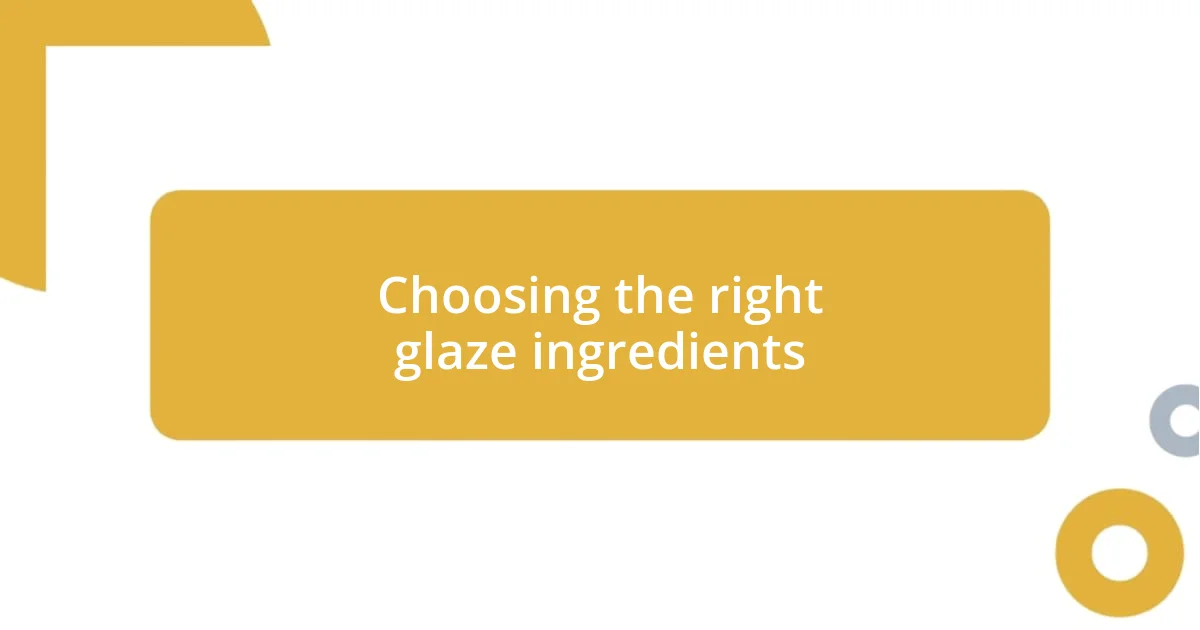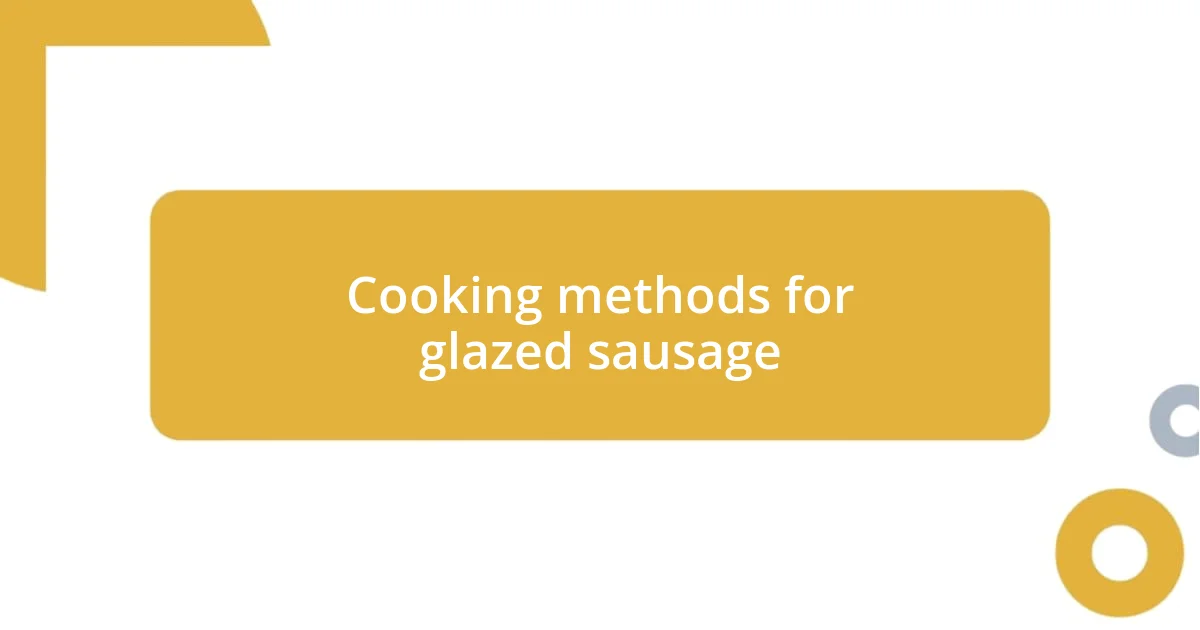Key takeaways:
- Use a combination of sweeteners, acids, and herbs to create a balanced and flavorful sausage glaze.
- Prepare sausages by ensuring they are at room temperature, patting them dry, and lightly pricking them before glazing for optimal adhesion and caramelization.
- Apply the glaze in the final minutes of cooking and allow sausages to rest afterward to enhance the overall flavor and presentation.

Understanding sausage glazing techniques
When diving into sausage glazing techniques, I often think about the transformative power of a well-executed glaze. The right glaze can elevate a simple sausage into a gourmet experience, creating a beautiful sheen that not only pleases the eye but also enhances flavor. Have you ever taken that first bite of a perfectly glazed sausage, the sweetness and smokiness mingling together? It’s a sensory delight that’s hard to forget.
One technique I’ve found particularly effective is the use of a honey-based glaze. I once made a batch of sausages for a gathering and decided to experiment with a mix of honey, mustard, and a splash of apple cider vinegar. The result was a sticky, caramelized exterior that had everyone asking for the recipe. This method not only provides a glossy finish but also complements the savory elements of the meat beautifully.
Another valuable approach is timing your glazing during the cooking process. I’ve noticed that applying the glaze too early can lead to burning, while waiting until the sausage is almost finished allows the sugars to caramelize just enough. Think of it like a dance; you want to gloriously balance the heat and the glaze, creating a symphony of flavor that makes your sausages memorable. How do you like to experiment with your sausage glazes?

Choosing the right glaze ingredients
Choosing the right glaze ingredients is crucial to achieving that perfect finish on your sausages. Personally, I love a balance between sweet and savory flavors. When selecting my ingredients, I often lean towards natural sweeteners like maple syrup or honey because they add richness without overpowering the meat’s intrinsic taste. Have you tried combining different sweet profiles? It can lead to delightful surprises!
Another aspect I consider is the acidity of the glaze. Ingredients like vinegar or citrus juice not only cut through the richness of the sausage but also brighten the overall flavor. I remember once making a citrus-soy glaze that included orange juice and soy sauce. The zesty kick lifted the sausage’s flavor to a whole new level, leaving my guests raving about “that tangy glaze.”
Additionally, herbs and spices can elevate your glaze even further. Fresh herbs or a dash of smoked paprika can create a layered taste experience. When I added fresh thyme to my honey glaze, it brought a subtle earthiness that paired wonderfully with the savory notes of the sausage. This extra touch can truly differentiate your dish and showcase your culinary creativity.
| Type of Ingredient | Flavor Profile |
|---|---|
| Sweeteners | Rich, caramelized |
| Acids | Zesty, brightening |
| Herbs/Spices | Earthy, aromatic |

Preparing your sausage for glazing
Preparing your sausage for glazing is an essential step that can make a world of difference in your final dish. I always start by ensuring my sausages are at room temperature; this not only helps with even cooking but also allows the glaze to adhere better. Once that’s done, I like to pat them dry with a paper towel to remove any excess moisture. This little detail seems minor, but trust me, it plays a huge part in achieving that brilliant, glossy finish.
Here’s a quick checklist to ensure your sausages are ready for glazing:
- Let sausages sit at room temperature for 30 minutes.
- Pat them dry with a paper towel.
- Prick the sausages lightly with a fork to allow the glaze to penetrate.
- Preheat your grill or pan before adding the sausages for even cooking.
Taking these steps makes the whole glazing process much more rewarding. I remember the first time I skipped the drying step; the glaze just slid right off, and I was left with a pile of sticky sadness instead of the glossy masterpieces I aimed for. It’s those little insights that transform cooking from a chore into a joyful experience!

Applying glaze for best results
Applying the glaze is where the magic truly happens. I’ve found that timing is crucial; I typically apply the glaze during the last few minutes of cooking to prevent burning. It’s exciting to see that transformation happen—the glaze turns shiny, creating an irresistible appearance. Have you ever pulled a sausage off the grill glossy and glistening, only to hear everyone’s mouths water?
One technique I swear by is using a brush for a thin, even layer. The brush lets me control how much glaze I apply, ensuring each sausage gets just the right amount. I recall one barbecue where I applied three coats of glaze, allowing each layer to caramelize. The resulting depth of flavor was incredible, and I could hardly believe the compliments I got. Don’t forget to keep an eye on them because it’s all too easy to get lost in the aroma and neglect that beautiful finish!
And remember, don’t skip the resting period after glazing! Letting the sausages rest for a few minutes allows the glaze to set and the flavors to meld. That moment of anticipation before cutting into one is part of the joy. I’ve learned that patience in this step richens the experience—trust me, the wait is worth the delicious first bite!

Cooking methods for glazed sausage
Cooking glazed sausage can be approached through various methods, each with its own unique flair. I often find roasting to be a fantastic option; the gentle, even heat allows the sausages to develop a beautiful crust while the glaze caramelizes perfectly. I still remember the first time I pulled a tray of roasted sausages from the oven—they were golden and the glaze had created this glossy sheen that immediately drew everyone to the kitchen. It felt like I had crafted a little masterpiece.
Grilling is another method I frequently use, and honestly, it brings such a wonderful smoky flavor that pairs exquisitely with the glaze. There’s something so satisfying about watching those grill marks develop, and I can’t help but think back to a backyard cookout where friends were eagerly lining up, eyes wide, as I brushed on the glaze. The heat from the grill creates that slight char that enhances the flavor, making my mouth water just thinking about it. Have you ever flipped sausages and seen the glaze sizzle? That’s when you know something magical is happening.
Then, there’s the pan-frying method, which is incredibly convenient. I love how quick it is—just a little oil, and you can achieve that lovely caramelization right on the stovetop. One time, I was in a rush, but I still wanted a fantastic meal. I heated my skillet, added the sausages, and by the time I finished preparing a quick side dish, they were glistening and ready to impress. It’s moments like these that remind me how versatile and forgiving sausage can be in the kitchen, making it possible to savor deliciousness even on a tight schedule. Wouldn’t you agree that the best meals often come from a bit of creativity and resourcefulness?

Tips for achieving optimal flavor
When it comes to enhancing flavor through glazing, I’ve discovered that mixing complementary ingredients can elevate the taste experience. For instance, incorporating a splash of citrus juice or a hint of spice can create a symphony of flavors that truly brings the sausage to life. One time, I experimented with a jalapeño-infused glaze, and the fiery kick was just the contrast I needed against the savory meat. Have you ever added a surprise element to your glaze? That unexpected twist can leave everyone guessing and wanting more.
Another point I can’t stress enough is the importance of high-quality ingredients. Opting for fresh herbs like rosemary or thyme can dramatically enhance your glaze’s flavor profile. I remember a gathering where I used freshly chopped parsley and garlic in my glaze. The aroma wafted through the air, and I could see people leaning in, captivated by the scent. It made me realize how much the right ingredients can transform not just the taste, but the entire dining experience.
Lastly, don’t underestimate the effect of temperature on flavor. Glazing sausages at the right heat ensures even caramelization and allows flavors to intensify. I once made the mistake of glazing over low heat, and while the sausages were perfectly cooked, the glaze fell flat. Since then, I always ensure my glazes have a little heat to work with. I’ve found that the perfect balance makes all the difference—would you agree that the right temperature can sometimes be the secret ingredient?















